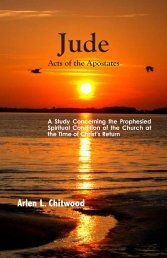Signs in John's Gospel - The Lamp Broadcast
Signs in John's Gospel - The Lamp Broadcast
Signs in John's Gospel - The Lamp Broadcast
Create successful ePaper yourself
Turn your PDF publications into a flip-book with our unique Google optimized e-Paper software.
Genesis, John 53<br />
people of God, which sets the whole of that which the Sabbath<br />
foreshadows before Christians as well (Heb. 4:9).<br />
<strong>The</strong>n note someth<strong>in</strong>g about the references to the Sabbath <strong>in</strong><br />
both Exodus and Hebrews. In each <strong>in</strong>stance, reference is made<br />
back to God’s work of restoration <strong>in</strong> Gen. 1:2b-25, with God then<br />
rest<strong>in</strong>g on the seventh day (Gen. 2:1-3; cf. Ex. 31:15-17; Heb. 4:3,<br />
4). Attention is called <strong>in</strong> each <strong>in</strong>stance to the established pattern,<br />
provid<strong>in</strong>g a parallel between God’s past work of restoration and<br />
His present work of restoration which no one should miss.<br />
Some call attention to the Apostle Peter’s statement <strong>in</strong> his<br />
second epistle (3:8), draw<strong>in</strong>g from the ru<strong>in</strong> and restoration <strong>in</strong><br />
Genesis, along with the events on the Mount of Transfiguration<br />
(1:15-18; 3:3-7), <strong>in</strong> an effort to show that each day <strong>in</strong> the latter<br />
restoration and rest is 1,000 years <strong>in</strong> length. However, this is like<br />
referr<strong>in</strong>g to the mention of 1,000 years six times <strong>in</strong> Rev. 20:2-7 to<br />
show the length of the com<strong>in</strong>g Sabbath rest.<br />
Both Peter <strong>in</strong> his second epistle and John <strong>in</strong> the Book of Revelation<br />
provide climactic material, material form<strong>in</strong>g apexes on the<br />
subject, material which had previously been dealt with extensively<br />
throughout portions of the Old and New Testaments, beg<strong>in</strong>n<strong>in</strong>g<br />
with the open<strong>in</strong>g chapters of Genesis.<br />
1) Compar<strong>in</strong>g Scripture with Scripture<br />
God’s work dur<strong>in</strong>g the six days <strong>in</strong> the open<strong>in</strong>g chapter of<br />
Genesis is usually understood and taught as creation alone (i.e.,<br />
verses describ<strong>in</strong>g God’s creation of the heavens and the earth, from<br />
verse one, over a six-day period of time). <strong>The</strong>n, what could only<br />
be part and parcel with this type thought, <strong>in</strong>dividuals <strong>in</strong>variably<br />
see little to no significance <strong>in</strong> the septenary structure of these six<br />
days when comb<strong>in</strong>ed with the follow<strong>in</strong>g seventh day of rest (cf.<br />
II Peter 1:15-18; 3:2-8).<br />
However, if Scripture is compared with Scripture, and the whole<br />
of subsequent Scripture is viewed <strong>in</strong> the light of that seen beg<strong>in</strong>n<strong>in</strong>g<br />
<strong>in</strong> Gen. 1:2, the preced<strong>in</strong>g couldn’t possibly be understood as<br />
the correct way to view this open<strong>in</strong>g section.<br />
<strong>The</strong> Hebrew words translated “without form and void” (tohu<br />
wavohu) <strong>in</strong> Gen. 1:2a are used together only two other places



